Related Content
Content
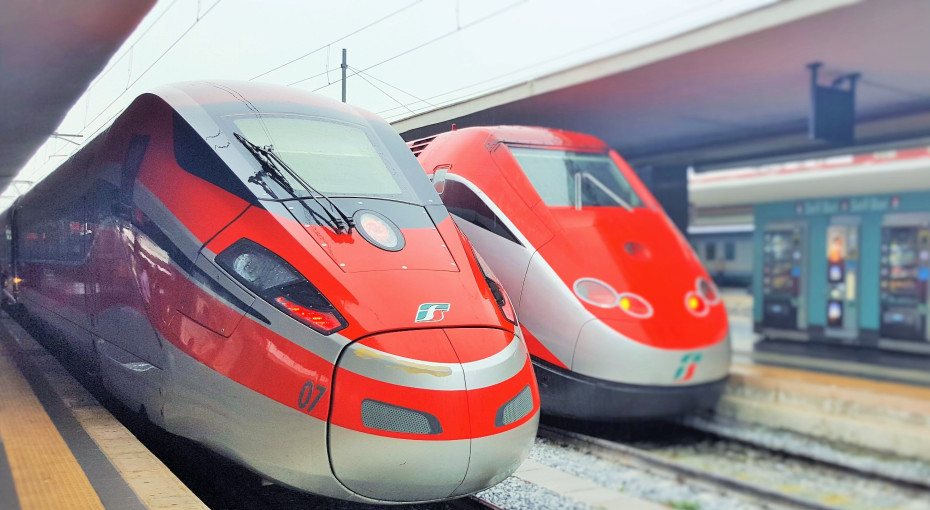
Travelling on Italian Trains
This guide provides insights to what you can expect on board, using tickets and which trains operate on the popular routes
Share
Welcome to ShowMeTheJourney's guide to travelling by train in Italy and on the international trains from and to Italy, it explains the differences between the types of train service; and includes insights into what you can expect on board.
So grab a coffee and discover all you'll need to make your Italian train travel experience to be as fabulous as possible!.
The word that best sums up Italian trains is ‘varied'; at one end of the spectrum are the majestic Frecciarossa 1000 trains, which are near the top of any best trains in the world list.
While at the other are trains that offer a more retro experience.
But for us that contributes to the charms of Italian train travel, stray away from the high speed lines and for the moment, you won’t be sure of the train travel experience that awaits you.
That’s because Italian trains are being rapidly modernised right across the country; the few remaining relics are being replaced by state of the art trains, while others are being updated.
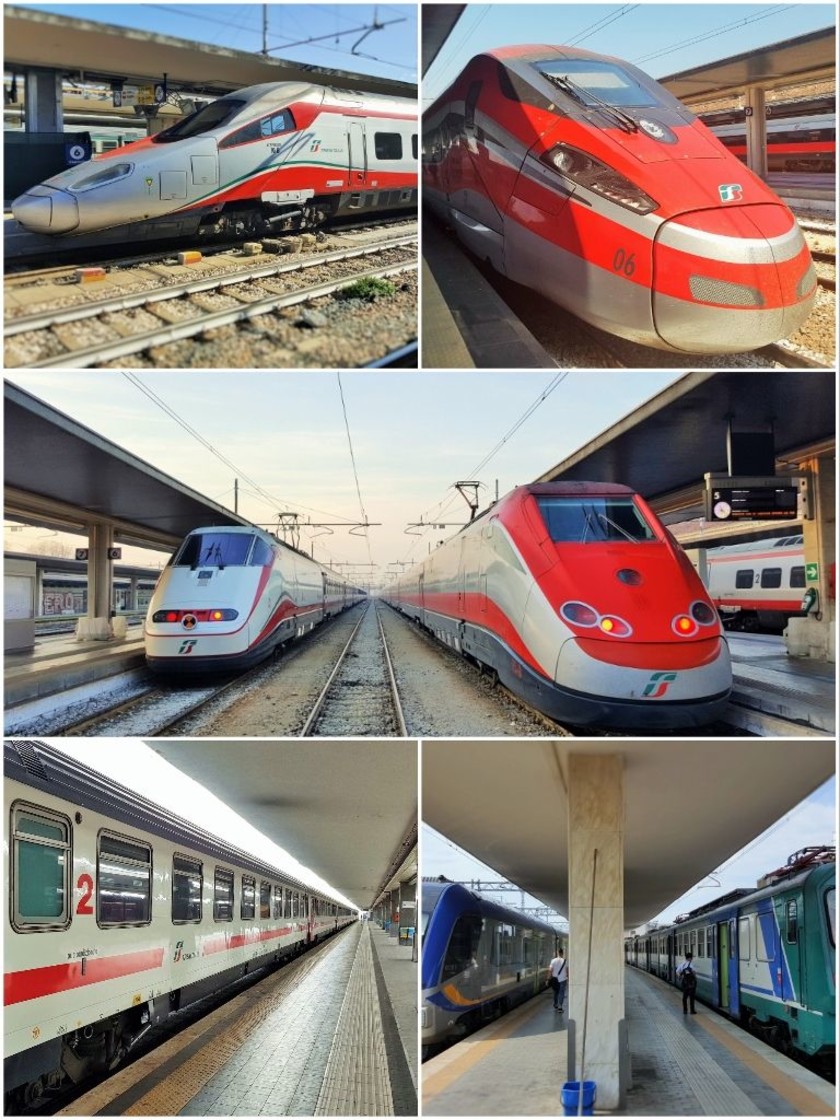
Non-Trenitalia trains
Not all trains in Italy are operated by Italy's national rail operator, Trenitalia.
The main exceptions are;
(1) Trains between Napoli/Naples and Sorrento.
(2) The majority of local/regional trains in northern Italy particularly to/from Milano - these trains are operated by Trenord.
(Eurail and Interrail passes are accepted on Trenord's trains)
(3) The majority of local trains in south east Italy including those from/to Bari and Lecce.
(4) Journeys by Italo AV high speed trains - these trains offer alternative services to Trenitalia's AV Frecce services on Italy's high speed railway lines,
Intro to the AV trains:
AV = 'Alta Velocita' - the English translation of which is 'high speed', so the AV trains are the trains which use the Italian high speed lines for all or part of their journey.
There are now two high speed lines in Italy:
(1) The main north <> south route which connects Torino/Turin <> Milano/Milan <> Bologna <> Firenze/Florence <> Roma/Rome <> Napoli/Naples <> Salerno.
(2) The first stage of the planned Milano <> Venezia/Venice high speed line has opened between Milano and Brescia.
Particularly worth knowing is that the Italian high speed AV trains are operated by Trenitalia = Frecce trains AND by NTV = Italo trains.
However, Frecciabianca trains, which rarely venture on to high speed lines, are also classified as AV trains by Trenitalia.
The Trenitalia services:
Trenitalia operates four different types of train services:
(1) Frecce = the faster AV trains - but Trenitalia operates six types of ‘Frecce’ train services.
(2) Intercity (IC) = non high speed express trains.
(3) Regionale Veloce (RGV/RV) = semi-fast trains that link larger towns and cities - particularly north of Rome.
(4) Regionale (R/REG) trains = local/stopping trains
Though some RGV/REG trains aren't operated by Trenitalia - particularly in the Milan/Lombardy area, where Trenord is the main operator.
Having some awareness of these different types of Trenitalia train service can make a big difference when travelling by train in Italy.
When travelling between most cities there will be a choice to be made between taking one or more of these services, with the most expensive prices charged for the faster types of train, meaning there will often be the opportunity to save money by taking a slower service.
This matters when booking a journey, tickets valid for the InterCity trains can't be used to travel by the Frecce trains and tickets for the Regionale trains can't be used to travel on the Frecce or InterCity trains.
The Abbreviations:
Note the use of abbreviations of the different types of train service - AV and RV etc, it's worth being aware of these as they are used on many of the departure screens at stations, so can be a big help in finding your train.
On the departure screens, the abbreviations for each type of train service precede the TRENO* number, which will also be printed on your ticket. (*Treno = train).
So if you see AV on a departure screen it will be indicating a Trenitalia Frecce train OR an Italo train, while IC always indicates an Intercity train.
Both RGV and RV can indicate a Regionale Veloce service, while both REG and R indicate Regionale trains.
If you are about to make a journey by Regionale train and there is an RGV or RV train on the departure board heading to you destination - take that train.
It will be a Regionale Veloce train, so will likely reach your destination quicker and your Regionale tickets will also be valid for the faster train.
Catering:
If you will be taking a long journey by train in Italy the advice is to take food on board with you.
No catering facilities of any kind are provided on the Regionale Veloce or InterCity trains and on the Frecce trains only a bar/bistro is provided, with a menu of salads and cold or toasted sandwiches.
Though don't overly rely on being able to order your first choice of items, on my two recent journeys by Frecce trains only one choice of sandwich was still available.
The train numbers:
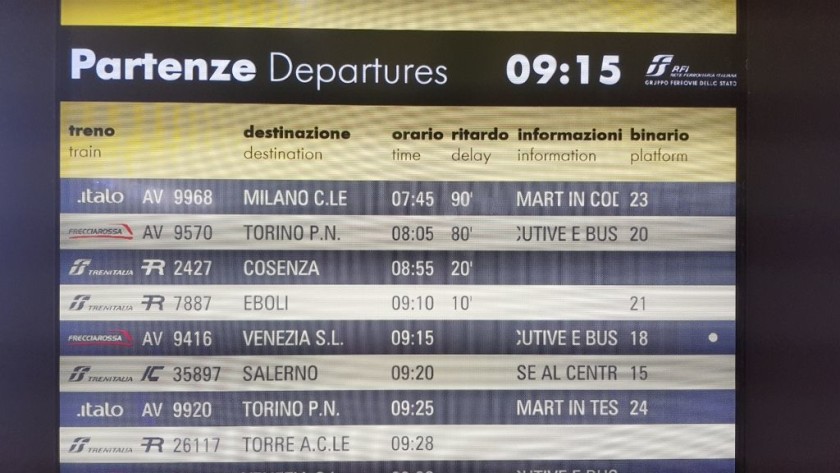
In Italy each individual specific train departure is given a train number - on tickets you will see 'TRENO' followed by a 4-digit number.
It is different from the numbers used for the departure and arrival times.
You can use this 4-digit number to help find your train at a station.
Not all departure screens at stations will show every station that a train will be calling at.
But if you match the train number - the 'Treno' number on your ticket to the Train/Treno number on the departure screens, you can be confident that you will be boarding the correct train.
In the example below it is the number after the 'AV', the 'IC' and the 'R' symbols
More info about using the departure screens to find your train is available on our Using Italian Train Stations GUIDE
The Frecce services:
There are six types of ‘Frecce’ (AV) trains operated by Trenitalia and what they all have in common are:
(1) There are no restaurant cars, the on board catering is provided by bistro/bars which sell hot and cold drinks, snacks, sandwiches and salads
(2) Theoretical access to a Wi-Fi portal - the connectivity can be patchy.
(3) Travellers in Business/First Class receive a complimentary at seat service of drinks and snacks
(4) All seats are reserved, so what ISN'T indicated on the trains is between which stations a seat is reserved for.
When boarding, if you want to change seats ask the conductor first - don't assume that a spare seat will be available for your entire journey.
(If you prefer to face forwards, note that all trains reverse direction when they call at these stations - Firenze S.M.N., Milano Centrale, Napoli Centrale, Roma Termini and Venezia S. Lucia)
In common with most European express trains the Frecciargento and Frecciabianca trains offer two levels of service, but the Frecciarossa 500 and Frecciarossa 1000 trains offer four classes of service.
In addition to Second/Standard class they convey:
- Executive class; lounges on the train that are akin to 1st class on airlines
- Business Class; more typical of the 1st class ambience on non-Italian high speed trains.
If you will be travelling with a 1st class Eurail or Interrail pass and purchase a reservation to travel on a Frecciarossa 1000 or Frecciariossa train this is where your seat(s) will be located.
For longer journeys this can be worth every cent of the €10 reservation fee/supplement! - Premium Class; more comfortable than standard class, more leg room and smarter seats, but less spacious than typical European 1st class coaches.
On the trains used for the Frecciarossa 600 and Frecciarossa 700 services, three classes of accommodation are available - Business, Premier and Standard.
Choosing between the type of Frecce services
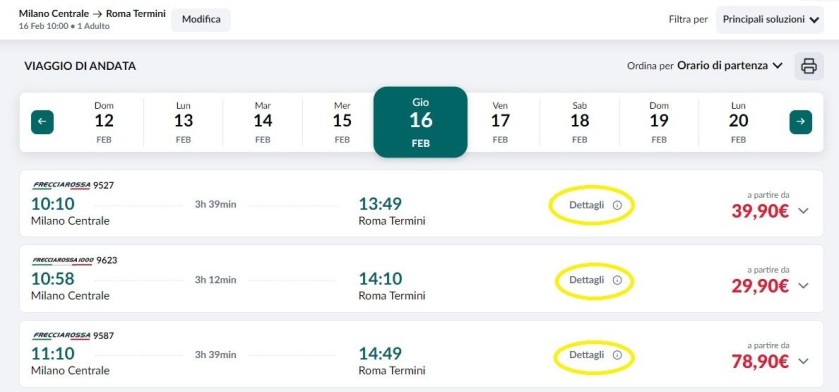
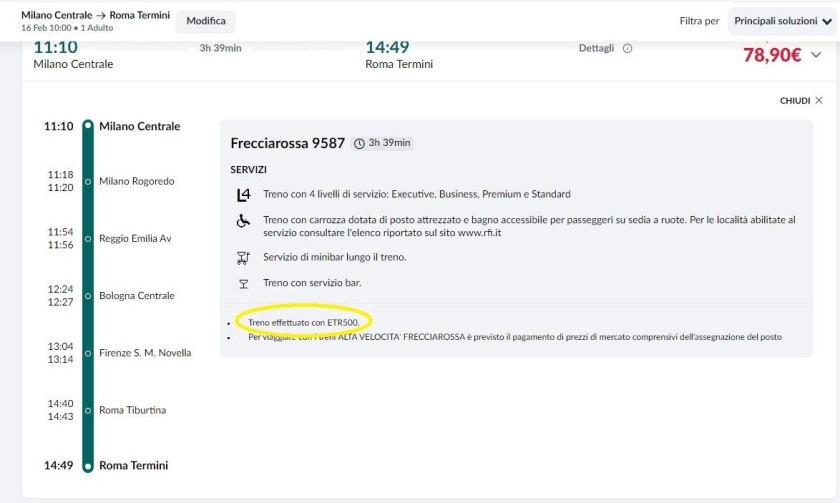
If Frecce sevices are an option for travelling between destinations, the service is often shared by different types of Frecce train.
When looking up a journey on Trenitalia, you can see which specific type of Frecce train are being used on each departure.
- Click on the info link which will be available on each departure.
- And the info is included in the box which will then appear
The type of train won’t affect the ticket prices; it is demand for each departure that will influence whether the cheaper discounted tickets are still available.
But if you DON'T need to arrive at your destination at a specific time AND different departures are similarly priced, the choice of train can matter to the journey experience, so can be worth keeping these three factors in mind:
1: If you will be travelling Business or Executive Class and want to experience the ultimate in high speed train travel, then choose the Frecciarossa 1000 trains.
But travelling in these classes on a Frecciarossa 500 train is still a delight.
2. If you will be travelling 1st class (the equivalents) with luggage, then our preference is to choose a Frecciarossa 1000 train nd not the Frecciarossa 500 trains.
In Business Class the Frecciarossa 1000 trains have more luggage racks than the Fercciarossa 500 train.
However, if you have luggage and will be travelling standard/2nd class, it can be worthwhile to target the Frecciarossa 500 trains, because they have slightly more luggage space in standard/2nd class than the Frecciarossa 1000 trains.
Large sized bags/cases won’t fit in the spaces between the seat backs in Standard Class on the Frecciarossa 1000 trains; so you have no choice, but to heave large bags up on to the overhead luggage spaces above the seats.
Frecciarossa 1000 trains
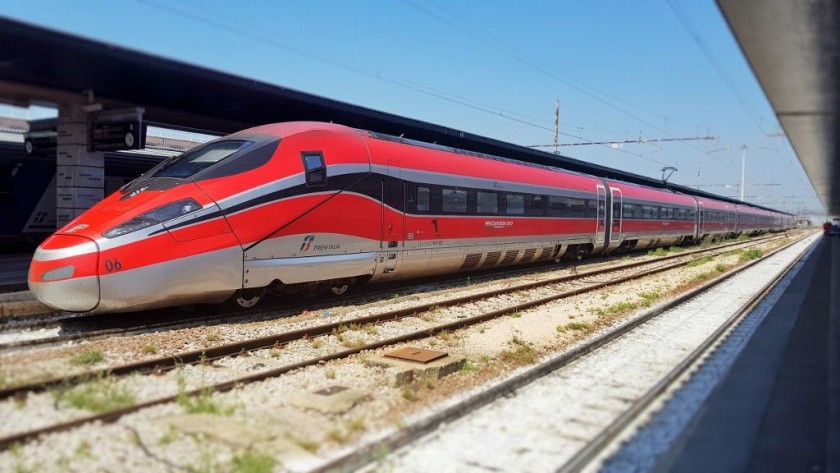
The rather fabulous Frecciarossa 1000 trains that tend to operate the fastest services of all on the main Torino - Milano - Bologna - Firenze - Roma - Napoli - Salerno high speed line.
So if you take one of the non-stop services between Milano and Roma, it's likely that you will be travelling on a Frecciarossa 1000 train.
They're also used for:
- some of the trains between Roma/Napoli and Venezia
- some some of the trains between Roma/Napoli and Verona, including the trains which travel beyond Verona to/from Bergamo.
- the trains on the Venezia – Padova - Vicenza - Verona - Brescia - Milano Porta Garibaldi - Torino route (the trains which travel beyond Milano to serve Torino)
- the new Milano Centrale - Torino - Lyon - Paris route.
Two Frecciarossa 100 trains can be joined together on some departures to make a train an exceptionally long train of 16 coaches/cars.
Note that 'Frecciarossa 1000' and 'Frecciarossa 500' are different trains.
Frecciarossa 700 trains
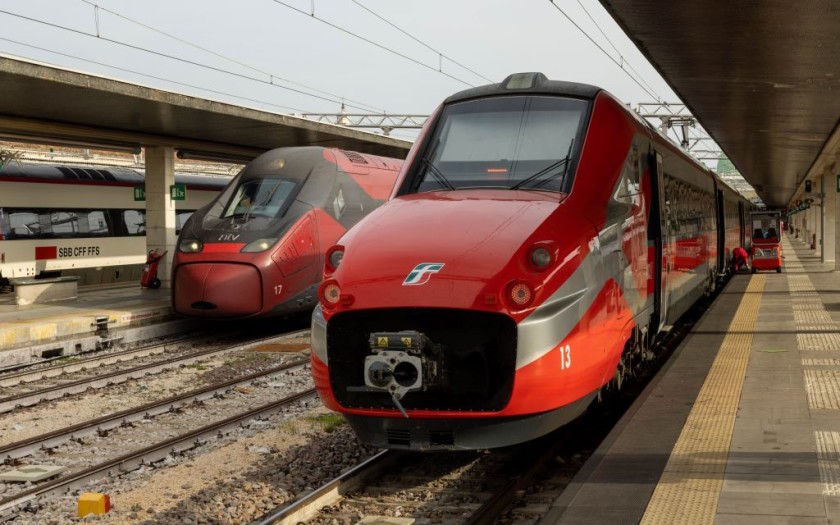
These trains had an unhappy time during a brief stay in The Netherlands, but they seem much happier in the Italian climate.
They now form most of the trains on these two routes:
- Milano Centrale - Brescia - Verona - Vicenza- Padova - Venezia Mestre - Venezia S.Lucia
- Venezia - Padova – Rimini – Ancona – Bari
And they are also used for a few services on this route:
Milano - Parma - Modena - Bologna – Rimini – Ancona – Bari
Frecciarossa 600 trains
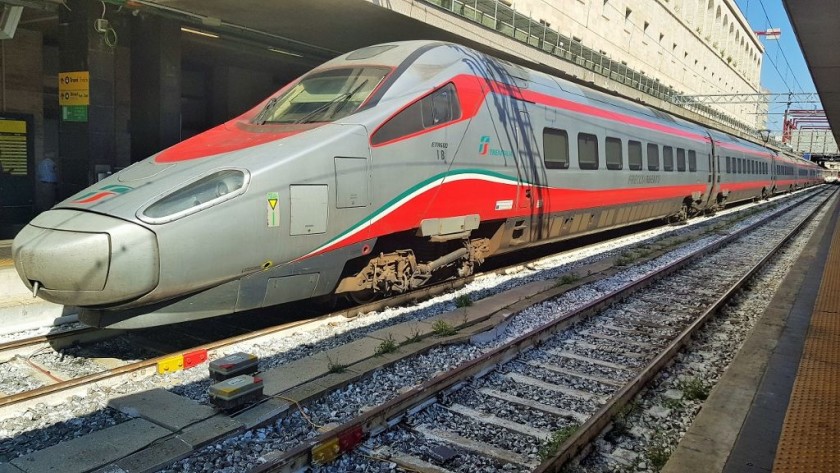
These trains, had recently been branded as Frecciargento, and they currently operate on two routes:
- Bolzano - Trento - Verona - Bologna - Firenze - Roma
- Trieste - Padova - Bologna - Firenze - Roma
Frecciarossa 500 trains
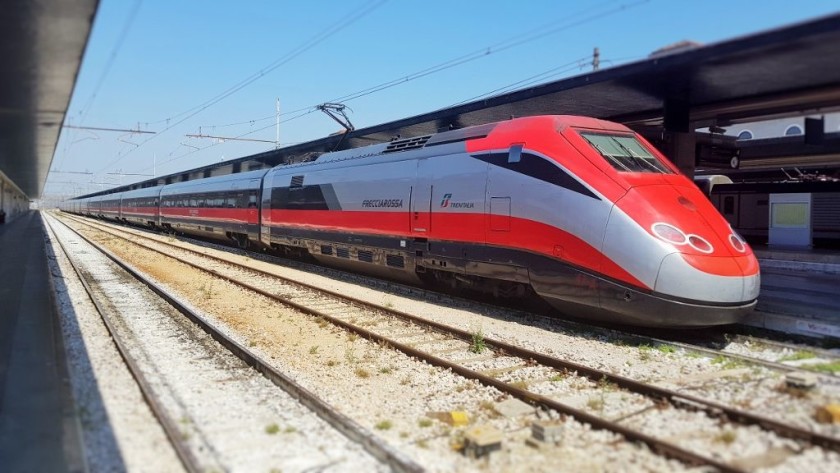
These Frecciarossa 500 trains operate some services on the Torino - Salerno high speed line, mainly the slower Trenitalia high speed services that call at both Bologna Centrale AND Firenze S.M.Novella.
In addition to the services on the Torino – Salerno high speed line (some of which now extend to Reggio di Calabria via Villa San Giovanni), Frecciarossa 500 trains now also operate on these routes;
- Venezia – Bologna – Firenze – Roma - Napoli
- Torino - Milano – Bologna – Rimini – Ancona – Bari
- Milano - Parma - Modena - Bologna – Rimini – Ancona – Bari - Lecce
- Milano - Bologna – Rimini – Ancona – Bari - Lecce
- Trieste - Venezia – Padova - Vicenza - Verona - Brescia - Milano - Torino (the daily direct train on this route to and from Trieste)
Frecciargento trains

These Frecciargento trains are deployed on services that use the high speed lines for a part of the journey only.
As a result the Frecciargento trains provide some of the services on these routes
2. Rome/Roma – Verona – Trento – Bolzano
3. Rome/Roma – Napoli - Villa San Giovanni - Reggio di Calabria.
They’re also the only trains used on the Roma - Bari - Lecce route.
Frecciabianca trains
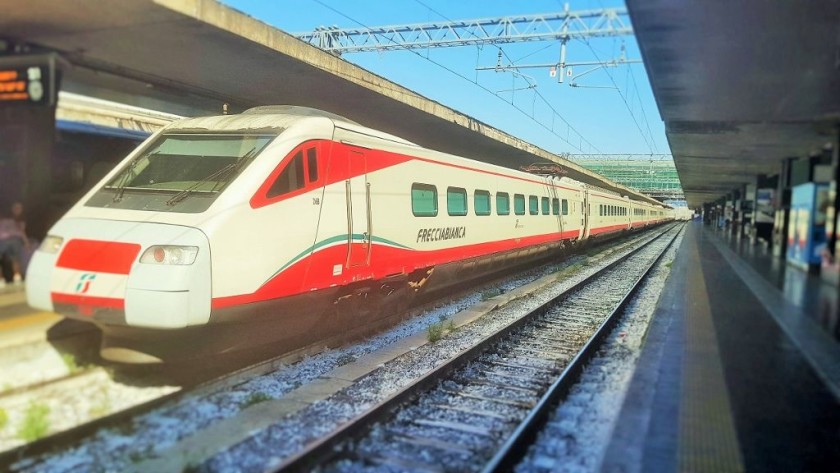
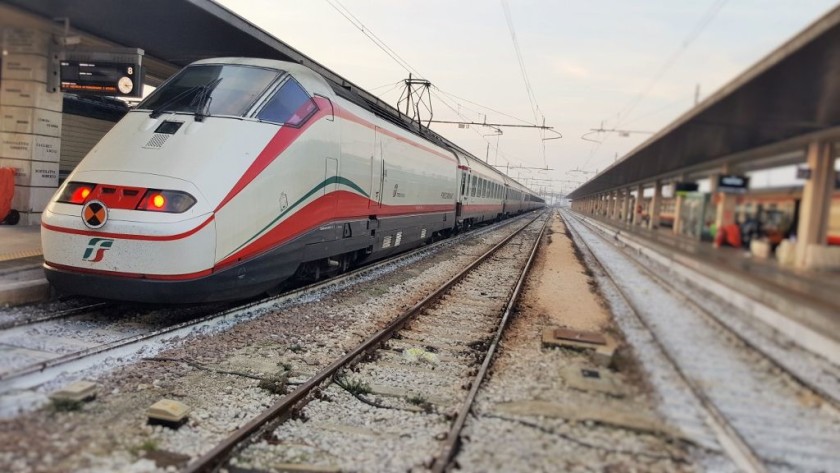
These are trains that rarely use the speed lines at all, but are faster than IC trains
There are TWO main types of Frecciabianca train:
(1) Frecciabianca trains that tilt so that they can take corners in the track at higher speeds:
The tilting trains are used on these routes:
- Roma - Livorno - Pisa - Genova - Milano/Torino (they're the fastest trains on this route).
- They also operate on the Rome/Roma – Rimini route
(2) The other Frecciabianca trains now provide the fastest services in Sicily.
The Italo trains:
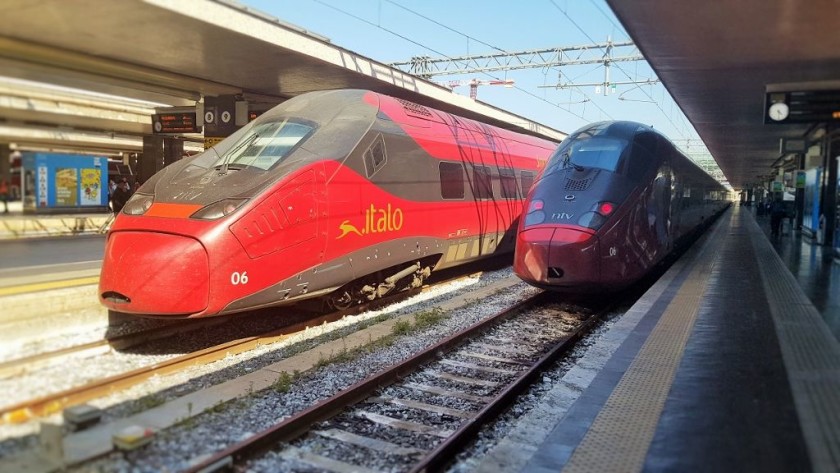
Italo high speed trains operate on many routes taken by Frecce trains.
They are operated by NTV and not by Trenitalia, so rail passes CANNOT be used on Italo services.
They share stations with Trenitalia’s AV trains but have their own ticket desks, ticket machines and lounges.
Trenitalia branded ticket counters and machines don’t sell tickets for Italo trains.
However, if you look up Italian train times and tickets on Trainline or Omio you can make a direct comparison between the prices and departure times of the Frecce and Italo trains.
First/1st class on Italo trains.
Similar to Trenitalia's Frecciarossa and Frecciarossa 1000 trains, Italo trains have four classes of service, but according to Italo's website it doesn't offer classes of services; instead it offers 'on board ambiences'
'SMART' is the equivalent of 2nd class (Standard class on Trenitalia's AV 'Frecce' trains).
'COMFORT is Italo's most basic superior service - seats are wider than those in Smart Class
It compares favourably to the intermediate 'Premium' Class on Trenitalia's Frecciarossa and Freciarossa 100' trains.
The seating is 2 x 1 in Comfort class on Italo, compared to 2 x 2 in 'Premium class on the Frecce trains.
PRIMA has power sockets, superior seats to Comfort - and complimentary drinks and snacks are provided.
Although Trenitalia has evidently risen to the challenge of the Italo trains - the Business Class on its new Frecciarossa 1000 trains is in a different league to the Prima class on these Italo trains.
'EXECUTIVE CLUB' - comparable to club class on airlines and 'Executive class Frecciarossa and Freciarossa 100' trains.
The seats are superior to those in Prima class and the seating saloon is much more spacious.
Some seats are arranged into lounges - so up to 4 people can have business meetings on the move.
What type of AV train should I choose to travel by
If ticket price is a factor then look up journeys on Trainline or Omio - Trenitalia's Frecce trains can be more easily compared with Italo services on these two booking sites.
Frecce or Italo:
If you will be travelling 2nd class the differences between the two services are more minimal - particularly when the choice is between a between a Frecciargento train and an Italo train.
Though in our humble opinion the differences are more noticeable when travelling in the equivalent of 'first class'.
Business class on a Frecciarossa 1000 or Frecciarossa train is more spacious than Prima class on Italo trains.
InterCity (IC) trains:
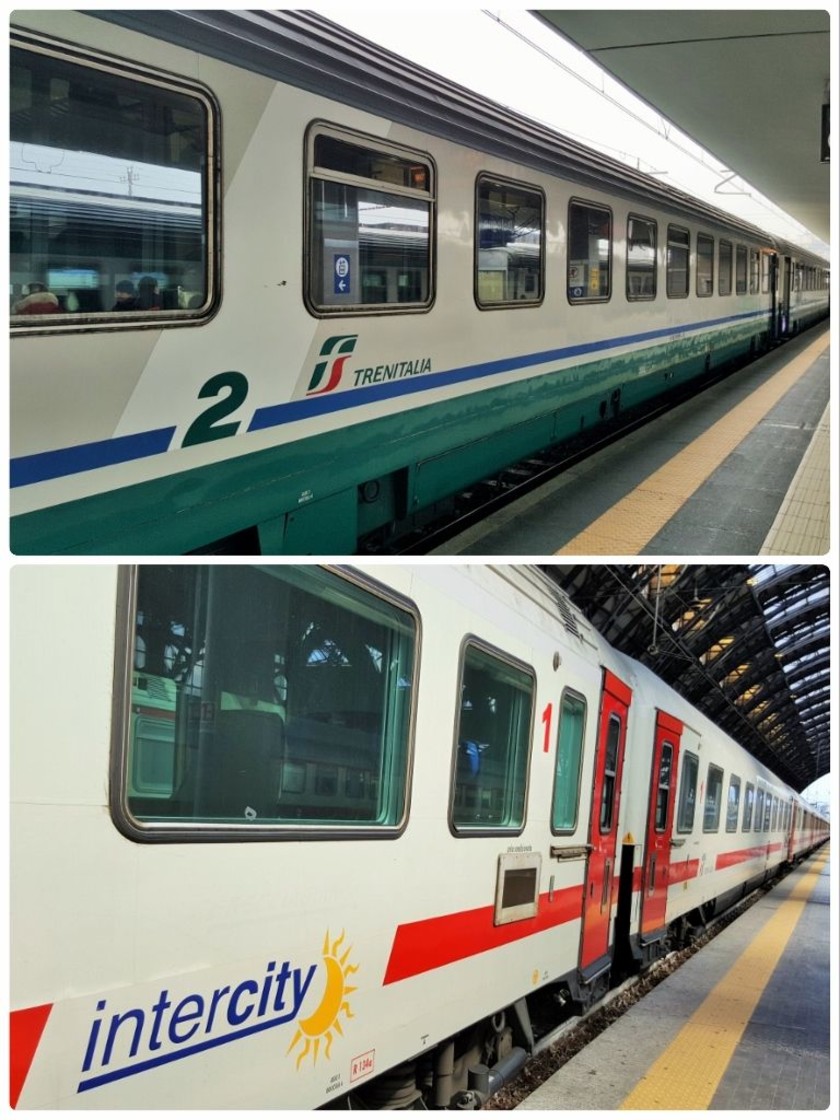
Intercity trains are slower (and generally cheaper) than Frecce trains because they're conventional express trains and rarely use the high speed lines.
Intercity trains are most COMMONLY found on these SEVEN routes:
(1) Milano – Genova – Albenga – San Remo – Ventimiglia
(2) Milano – Genova – Sestri Levante – Monterosso – La Spezia – Pisa – Livorno – (Grosetto) - (Roma)
(3) Milano – Parma – Modena – Bologna – Firenze Rifredi – Arezzo – Roma Tiburtina – Napoli (a slower, cheaper, alternative to the AV trains)
(4) Trieste – Venezia Mestre – Bologna - Firenze Rifredi – Arezzo – Roma (a slower, cheaper alternative to the AV trains between Venezia and Roma)
(5) Milano - Parma – Modena – Bologna – Rimini – Ancona – Bari – Taranto (a slower, cheaper alternative to the AV trains between Milano and Bari)
(6) Roma – Taranto
(7) Roma – Napoli – Villa San Giovanni – Messina – Palermo and Catania – Siracusa; these are the only direct daytime trains between Italy and Sicily.
A refurbishment program is underway to update the interiors and exteriors of Italian Intercity trains.
A new colour scheme of red and white is being applied - and SOME of the trains that are now red and white have been refurbished.
Trains that are still painted blue/grey are less likely to have been refurbished.
You won't know if you will be travelling on a refurbished train when booking tickets.
The refurbishment includes the addition of features such as on-board info screens, Wi-Fi and power sockets.
Though what is common to all InterCity services is that no catering facilities will be available on board the trains, they don't convey bar counters or restaurant cars and no catering trolley service is provided
Seat reservatations
Whether you don't OR do have a rail pass:
For ticket holders, reservations are mandatory on IC trains and the AV trains, but seats are automatically assigned when booking tickets online and at stations.
When you book tickets for these trains on the Trenitalia website, you can select seats on a seating plan, but you won't know if the seats you choose will be facing forwards.
On your ticket the 'carrozza' number is the coach/car number and the 'posti' is the seat number
As all seats are reserved on Frecce and Italo and Intercity services, what isn't indicated on board is the destinations between which the seat is reserved for.
When boarding, if you want to change seats ask the conductor first - don't assume that a spare seat will be available for your entire journey.
If you prefer to face forwards, note that all trains reverse direction when they call at Firenze S.M.N., Milano Centrale, Napoli Centrale, Roma Termini and Venezia S. Lucia.
Using rail passes:
When using the new Trenitalia Passes the reservations on the trains on which these passes can be used - Frecce, Intercity and Intercity Notte, are automatically included when booking journeys.
Journeys must be pre-booked prior to boarding.
Eurail and InterRail Passes
Because all seats are reserved on Frecce trains Eurail and Interrail users have to pay reservation fees prior to boarding,
If you have any type of EURAIL or INTERRAIL pass valid in Italy, the reservation fees for any journey, no matter the distance, are now €13 for 1st AND 2nd class pass users
(This price does not include booking fees, because you don't need to pay a booking fee when making reservations on ItaliaRail or at an Italian station ticket machine).
In contrast to ticket holders rail pass users can opt to reserve on Intercity trains when travelling from October to April (except on and around national holidays) but they are mandatory between May and September = €3 for 2nd AND 1st class pass users
Making the reservation for longer-distance journeys in October to April is highly recommended because ticket holders will all have assigned seats, so it's likely that any seemingly available seat will be claimed at some point during a journey,
These rail pass reservations can be purchased from Trenitalia branded ticket machines or a ticket desks.
Reservations are not required for journeys by Regionale Veloce and Regionale services and rail passes CANNOT be used on Italo trains.
Much more info is available on our using Rail Passes in Italy GUIDE
Regionale / Regionale Veloce trains:
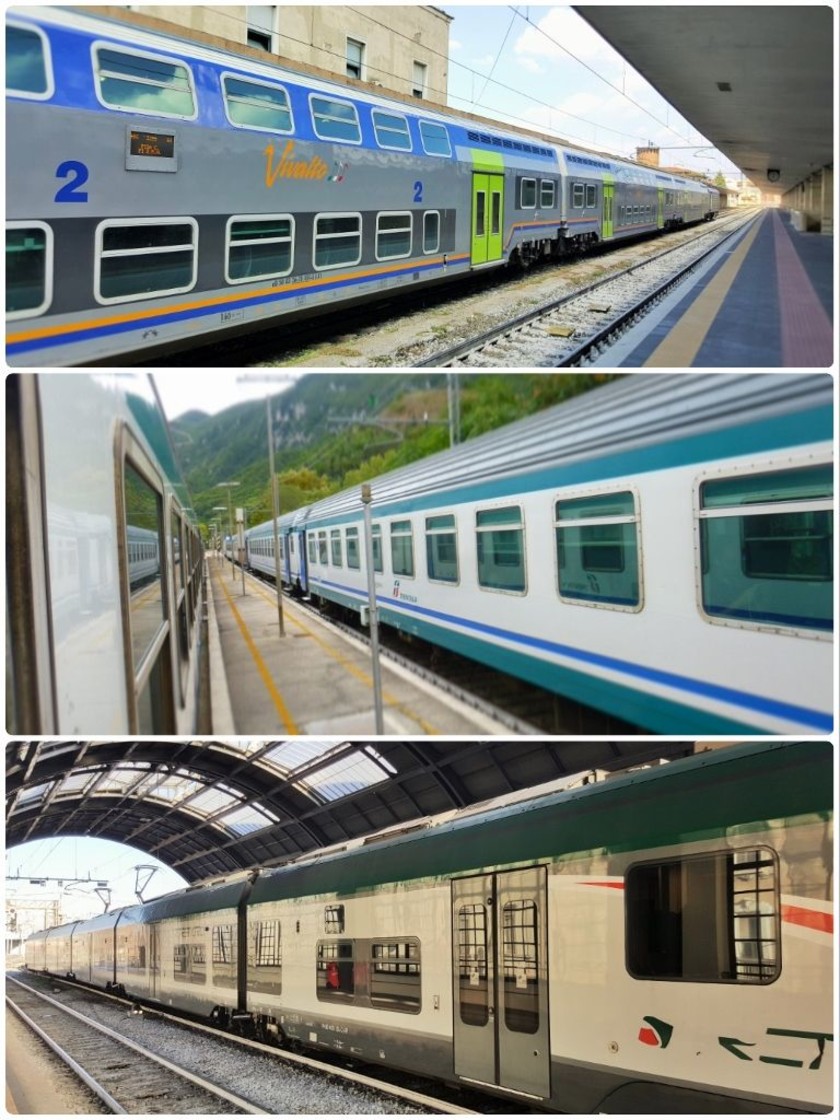
Regionale Veloce (RGV) and Regionale (REG/R) trains are similar, but different services - note the use of the word 'services', that's because multiple different trains are used across Italy on the routes taken by these trains.
For some reason Trenitalia tends to use some of its oldest trains for Regionale Veloce services – though brand new trains are being introduced.
The trains used for Regionale services can vary between some of the oldest trains in Europe and brand new single and double-deck trains, but what is common to all of these services is that neither seat reservations, or catering, will be available.
However, they are the only Italian train services on which non-folding bicycles can be taken on board without being disassembled.
Tickets for Regionale Veloce train services cost the same price as the slower Regionale trains - when both types of service are available.
Tickets have to be stamped in machines before boarding Regionale REG/RGV trains – but not when boarding express trains.
The difference between Regionale Veloce and Regionale services:
Regionale (REG) trains are predominantly local services, while Regionale Veloce (RGV) services link towns and cities over longer distances.
So Regionale Veloce (RGV) services can be much faster than Regionale (REG) services because they call at fewer stations.
On some routes Regionale Veloce trains provide a cheaper (and not much slower) alternative to Frecce and Intercity services,
Most Regionale train services are 2nd class only, but 1st class is an option on the majority of Regionale Veloce services.
It can be worth paying a few €s extra for 1st class tickets on Regionale Veloce services.
Because seats can’t be reserved on these trains they can be very crowded, particularly in the summer months and you’ll have more chance of finding a seat in 1st class.
Using Italia In Tour passes
ITALIA IN TOUR 3 and ITALIA IN TOUR 5 passes can be used for travel solely by the slower Regionale (R) and Regionale Veloce (RV) trains operated by Trenitalia.
They allow for unlimited travel by these trains for three or five consecutive days from the first day of travel and can be purchased on the Trenitalia website or from station ticket offices and Trenitalia ticket machines.
The passes can be used on the Leonardo Express, which connects Roma Termini station and the city's main airport, but they are not valid on:
- trains to/from stations in the Cinque Terre national park
- trains not operated by Trenitalia including those around Bolzano and on the route between Trento and Bassano del Grappa
- trains operated by Trenord, including the Malpensa Express services.
Note that Trenord is the dominant operator of R and RV services in and around Milan, so routes taken by these trains, on which the Italian Tour Passes cannot be used include trains between Milan and Bergamo, Brescia, Domodossola, Lecco, Stresa, Tirano and Verona.
Look for a journey guide
Overnight trains:
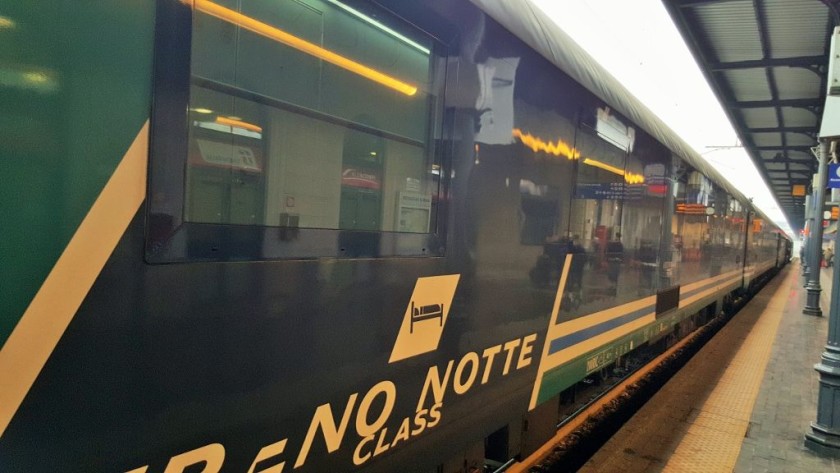
Trenitalia operates 'Treno Notte' overnight trains on these SEVEN routes (the ↔ symbol indicates which part of the journey is overnight).
(1) Roma ↔ Trento - Bolzano
(2) Roma ↔ Venezia/Venice - Treviso - Udine - Trieste
(3) Roma - Napoli ↔ Messina - Palermo and Siracusa
(4) Milano - Genova - La Spezia - Pisa - Livorno ↔ Messina - Palermo and Siracusa
(5) Torino - Milano - Genova ↔ Napoli - Salerno
(6) Torino - Milano - Bologna - Firenze - Roma ↔ Villa San Giovanni - Reggio di Calabria
(7)Torino and Milano - Piacenza - Parma - Modena - Bologna - Rimini ↔ Bari - Lecce
When looking up some early morning journeys on Trenitalia, an option can be to travel on an 'Trenno Notte' as they have ordinary daytime style coaches.
However, avoid if possible, as it's not that unusual for Trenno Notte trains to be running more than an hour late after they have travelled overnight.
International Day Trains:
All trains operate in both directions and all services marked with an asterix require a reservation - automatically included when buying a ticket online or a station.
Destinations in brackets have less frequent services - usually only 1 x train per day.
Note that Bologna is the most southern Italian city served by international daytime trains from/to Italy.
(1) EuroCity* (EC) trains, operate on these FOUR routes:
(1) (Bologna/Genova/Venezia) - Milano Centrale - Como - Lugano - Bellinzona - Arth Goldau - Zug - Zurich
(2) Milano Centrale - Como - Lugano - Bellinzona - Arth Goldau - Luzern - Basel
(3) (Venezia) - Milano Centrale - Stresa - Domodossola - Brig - Sion - Montreux - Lausanne - Geneve
(4) Milano Centrale - Stresa - Domodossola - Brig - Visp - Spiez - Thun - Bern - Olten - Basel (- Freiburg - Karlsruhe - Mannhein - Frankfurt (Main*)
*These trains take a different route between Basel and Milano in the opposite direction from Germany TO Italy.
In that direction the route is Frankfurt - Mannheim - Karlsruhe - Freiburg - Basel - Luzern - Bellinzona - Lugano - Como - Milano
(2) EuroCity* trains formed of Austrian IC trains operate on these routes:
(Venezia - Padova) AND (Bologna) - Verona – Trento - Bolzano - Brennero - Innsbruck - Kufstein - Munchen/Munich
(3) Austrian Railjet trains operate on this route:
Venezia - Treviso - Udine - Villach - Klagenfurt - Wien/Vienna
(4) Italian Frecciarossa 1000 trains operate on this route:
Milano Centrale - Torino Porta Susa – Chambery - Lyon-Part Dieu - Paris Gare de Lyon
(5) TGV - France-Italy* trains operate on this route:
Milano Porta Garibaldi – Torino Porta Susa – Chambery – Paris Gare de Lyon
Tickets for this TGV France-Italy train service are not sold by Trenitalia at stations or online.
Also note that these trains depart from Milano Porta Garibaldi station and NOT from Milano Centrale.
(6) Swiss IC trains operate on this route:
Domodossola - Brig - Visp - Spiez - Thun - Bern - Olten - Basel
(7) Regional (Ticino) trains operate on this route:
Milano Centrale – Como – Chiasso – Lugano – Locarno
connect in Lugano for trains to Basel and Zurich
(8) Local trains operate on these SIX routes:
(1) Chiasso – Lugano – Bellinzona
(2) Domodossola – Brig (infrequent trains)
(3) Domodossola – Locarno (Centovali, narrow gauge mountain railway)
(4) (Bologna - Trento) - Bolzano - Brennero - connect for trains to Innsbruck
(5) Ventimille/Ventimiglia – Menton – Monte Carlo – Nice – Antibes – Cannes – St Raphael – Grasse
(6) Udine – Villach (infrequent trains)
Why can it be easier to travel TO Italy by train than from Italy?
It CAN be easier to travel TO Italy by train than from Italy by train on SOME international routes, the THREE reasons being:
(1) Two of the three daily TGV - France-Italy trains from Milano to Paris depart from Milano before any long distance trains have arrived in Milano from other cities.
As a result daytime connections from virtually all other Italian cities, are reliant on the one other daily train service - which doesn’t arrive in Paris until late evening.
(2) The direct daytime train from Venezia/Venice to Muenchen/Munich arrives too late in Munchen for connections into ICE trains to many other German cities.
(3) The direct daytime train from Venezia/Venice to Geneve doesn’t arrive in Geneve until after 23:30.
International Night Trains:
OBB Nightjet](/travel-on/train/96-obb-nightjet-international/)** trains operate on these FOUR routes:
(1) Roma - Firenze - Leoben - Wien/Vienna
(2) Milano - Brescia - Desenzano - Verona - Leoben - Wien/Vienna~
(3) Roma - Firenze - Innsbruck - Munchen/Munich
(4) Venezia/Venice - Treviso - Udine - Linz - St Polten - Wien/Vienna
Please support ShowMeTheJourney
This second version of ShowMeTheJourney is exciting and new, so we are genuinely thrilled that you are here and reading this, but we also need your help.
We’re striving not to let anything get in the way of providing the most useful service possible, hence a facility has been set up with DonorBox which can be used to support the running costs and make improvements.
Instead of advertising or paywalls, your financial support will make a positive difference to delivering an enhanced service, as there’s a lot of ideas which we want to make happen.
So if you have found the info provided here to be useful, please go here to say thank you.
General guides to using trains:

Simon Harper
I wanted to share my passion for train travel and explain how anyone can take the fantastic journeys I have taken.

This is one of more than 100 train travel guides available on ShowMeTheJourney, which will make it easier to take the train journeys you want or need to make. As always, all images were captured on trips taken by ShowMeTheJourney.
This second version of ShowMeTheJourney is exciting and new, so we are genuinely thrilled that you are here and reading this, but we also need your help.
We’re striving not to let anything get in the way of providing the most useful service possible, hence a facility has been set up with DonorBox which can be used to support the running costs and make improvements.
Instead of advertising or paywalls, your financial support will make a positive difference to delivering an enhanced service, as there’s a lot of ideas which we want to make happen.
So if you have found the info provided here to be useful, please consider saying thank you.








